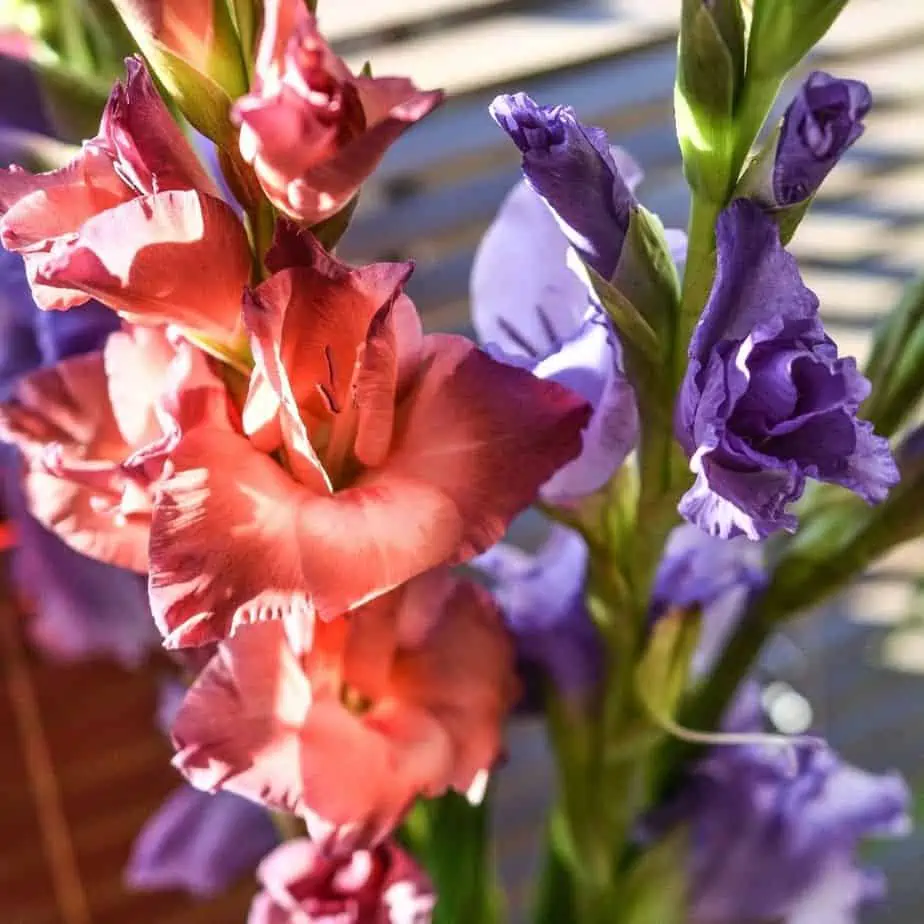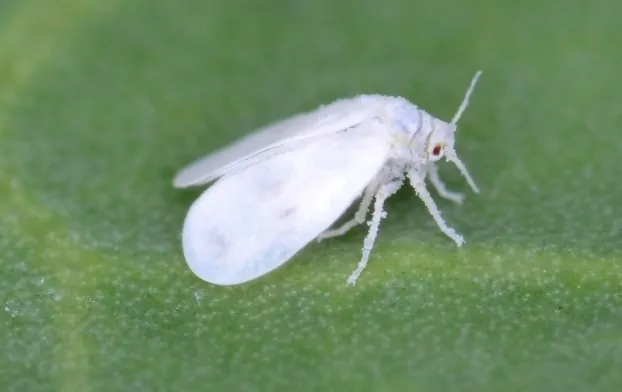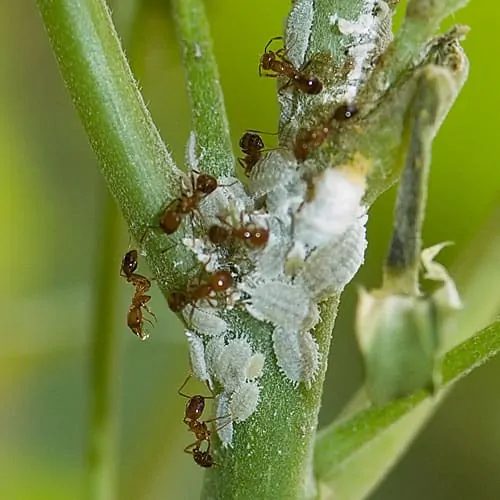Today we will discuss Gladiolus Pests and Disease Treatment. Gladiolus or Gladiolus spp. is a flowering plant. It grows from seeds as well as corms. These plants are pretty easy to grow and care for. If you need any information then read How to Grow Gladiolus Flowers?. Gladiolus is suitable to grow in USDA zone 8 through 11 as perennials. Some varieties can even grow in colder Zone 2 to 5. Technically these plants only bloom once every year and then the plant dies. Their bulbs or corm remain alive in the soil, especially in warmer regions. In other places, you have to dig out the bulbs to protect them from freezing.
This periodic occurrence makes this plant a suitable member for annual flowers. Gladiolus flowers are very popular as cut flowers. Every single plant develops 1 flower spike with 10-15 flower buds. You can harvest the spike once a couple of lower flower starts to bloom. Keep it in a flower vase with clean water and it will bloom for the next 20-25 days. Gladiolus is a hardy summer plant. It can survive mild drought-like conditions although it is not fully immune to drought and other problems. Gladiolus plants are also susceptible to common garden pests and diseases. They are inevitable yet quite easy to handle. You just need to learn more and stay aware of the problems.

Why do Pests Attack gladiolus plants?
The entire lifecycle of any pest or insect depends on proper feeding and a comfortable habitat. They spend their whole life in search of warm dark humid spots in plants. They need a cozy place to feed and breed. This requirement is fulfilled by the Long blade-like Gladiolus leaves.
Even the buds and leaf nodes are good hiding spots for many insects. In these close spots, pests can hide and stay safe from predators and bright sunlight. these perfect spots are ideal for feeding and bedding. Mostly sap-sucking insects like suck areas. Leaf cutters like caterpillars can roam freely during the night.
The Gladiolus plant is not very prone to serious disease. If the condition is not favorable or there is too much moisture on the leaves then pests can attack them. Usually ew plants with tender leaves or newly formed flower buds are more prone to pest infestation.
Read: How to Grow Petunia Plants? Easy Container Gardening
Is it easy to Control Gladiolus Pest and Disease?
It is easy to treat pests during an early infestation. The situation can become worse with the introduction of diseases. Pests like damp hiding spots in leaf nodes and near flower buds. If we care for the plant by regulating moisture then half of the problem is solved.
Pests especially the sapsuckers attack soft tissue. They scrape the skin and then feed directly on plant sap from veins. The Gladiolus plant can handle the sucking problem by healing those scrape wounds. It only requires proper nutrition and care to build its immunity and fight back.
The problem becomes troublesome when the pest population escalates. They bring fungal spores, bacteria, and deadly viruses. These new pathogens can weaken the plants’ immunity. It may lead to shunted growth, loss of strength, curling, and wilting.
Together pests and disease can make it difficult to treat the gladiolus plant. Therefore stay aware and start active pest control and disease treatment before it affects the gladiolus plant.
Common Pests in Gladiolus Plants
There are a few garden pests that can harm your gladiolus plants. These are-
Aphids
Aphids are tiny sap-sucking bugs. They are easy to spot on the lower side of infected plant leaves. If infestation is worse then you can find then on buds and flowers. Aphid treatment is easy if you keep the plant clean and its foliage dry. Spray the infested plant with soap water and neem oil twice every week. Keep in mind aphids can carry deadly plant viruses therefore severely infected gladiolus plants are hard to treat. Although you can save their bulb for next season.

Whiteflies
Tiny whiteflies are easy to spot on green foliage. They prefer shady areas and humid environments. Usually, they attack gladiolus plants during cloudy days. Whitefly treatment is quite easy, just keep the plant dry. You can use a water jet to distract them although it would be better for the plant if you let it dry in sun without water. Neem oil spray is helpful and can distract whiteflies away.

Mealybugs
These are nasty little white bugs. They are not white, their wax covering made them look so. It is hard to treat them with common pesticides especially due to their waxy covering. Mealybug infestation can cause shunted growth, deformation of plant head, premature buddying. They mostly attack plants kept away from direct sunlight. You have to get rid of their coverage before any pesticide treatment. Use rubbing alcohol to dissolve the wax then spray these bugs with pesticides to kill them.

Thrips
Thrips are sapsuckers. They usually attack the tender plant foliage. Severe thrips infestation can shunt the plant growth and turn the leaves yellow. The infected plant can lose its strength to develop flower spikes. If the gladiolus plant has a flower spike then it may not bloom properly. Neem oil can be helpful in an early infestation.
Spider mites
These tiny mites are barely visible by naked eyes. Although you can identify them by thin web left on their attack spots. Sometimes they can be seen wandering on the leaf surface. Spider mites can slow down plant growth and eventually lead to the deformation of foliage and flower buds. Water jets can wash them off and if necessary use pesticides.
Caterpillars
Moth larvae and caterpillars can chew tender leaves and buds. Remove them manually from the plants and spray the plant with general-purpose insecticides. Caterpillar usually won’t affect mature gladiolus plants. therefore protect small immature plants and their tender parts from caterpillars.
Budworm
Budworms feed on underdeveloped buds. They are the larvae of other insects that dig deep into buds and eat them from inside. The infected bud will drop before flowering. Even if it opens the flower will be deformed. Hot water treatment can help with the Budworm problem.
Beetle Grub or Larvae
Beetle Grubs and larvae can eat the bulb in the soil. You won’t notice the infestation until the plant dies and you dug out the bulb. The problem is not very hard to solve yet the identification is a big problem. ost plant dies before any sign of infestation occurs. Therefore treat the soil with fungicide and pesticides before planting gladiolus bulbs. Also, check the bulbs for any infestation before planting.
Japanese Giant Beetles
These giant Japanese beetles have become a big problem in the last 8-10 years. They attack the plant in hoards. They eat every foliage, bud, and flower leaving the plant like a skeleton. These huge beetles usually don’t prefer certain plants. They can attack every soft body plant in your garden, especially flower plants. Bug traps and special pesticides or insecticides can help in their treatment. Japanese Beetle: How to get rid of these bugs?- Myth Busted
Disease That can Damage gladiolus Plants
Gladiolus diseases are mostly spread by pests and infected garden tools. Even a splash of water can spread it from one plant to another. It is not easy to protect a gladiolus plant unless you take care of pests infestation. Gladiolus plant diseases are hard to cure. The most infected plant will stop growing and eventually die. The best option, in this case, is to get rid of the infected plant for sake of others.

Check out How to Care for Gladiolus Plants?
Common Diseases that can affect a Gladiolus plant are-
- Fusarium Wilt
- Powdery mildew
- Bulb or Bud rot
- Rust
- Aster Yellow Spot
- Mosiac virus
Curling of leaves, deformation of buds, dying of flower before maturity, dark or yellow-brown spots on leaves and flower stalks, all of these can be signs of gladiolus diseases. It is better to take precautions before your plants get infected. Often the infected plant will die and there is no way to save them properly.
So chemical treatments are available but they work on specific problems. Therefore it is good to keep your gladiolus plants safe from pests and diseases. Final Advice never uses dirty garden tools as they can spread fungal spores and vial diseases.
How To Treat Common garden Pests in Gladiolus?
Early protection is the first step in pest control. Start by keeping these plants clean and dry. Allow them full sun and avoid watering on the foliage. Never water after sunset and let the soil dry before watering. Also, maintain proper space between each plant. Space will allow air to circulate properly and keep pests away.
If you follow these simple steps then half of the pest problem is already solved. Treat the rest with neem oil and soap water spray.
Chemical pesticides should be your last option. Try everything else before chemicals. You can also introduce predator insects like a parasitic wasp and ladybug in your garden. They can feed on aphids, thrips, and whiteflies. This is the natural pest control measure for your garden. Nature knows well to maintain a balance. You just have to give it a helping hand.

Also, read Petunia Plant Care: Pest Problems and Solutions
Prevention for Gladiolus Diseases
Plant Diseases are related to one or many carriers. they usually spread with the help of a carrier like a pest or any infected garden tool. Sometimes we humans can also act as a carrier for these diseases. Fungal spores can travel long distances with our boots, dress, and even pet fur.
Treatment of gladiolus plant diseases is practically useless. The infected plant will never bloom in the season even if you save it for the diseases. The disease itself is pretty hard to cure. Most of the time infected plants will die and you may not be able to save them. therefore it is better to protect the plants from infection instead of treating an infected one.
- Keep the plants clean and pest free.
- Use clean sanitized gardening tools
- Avoid overwatering
- Treat soil with fungicide before plantation. Also, dry the soil in sun or fry it at 120 Degree for 10 minutes. It will kill every possible fungal bacterial or viral strain. Use the soil after cooling.
- Always use dry-aged compost or manure after treatment with fungicides.
- Use healthy Gladiolus bulbs to grow.
- Regularly use soap water and neem oil to deter pests so that they can’t spread diseases.
If you carefully follow these simple steps then you won’t have to worry about gladiolus pests and disease.

